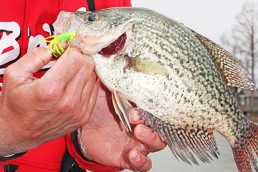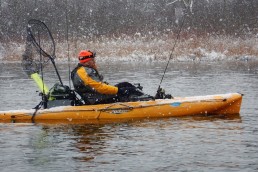Three Crappie Structures for Cold Water
SHARE THIS POST
Consistently catching crappies in cold water isn’t an accident. A fisherman must use mapping, electronics and fish the right spots. A good plan can lead to success even in the coldest soft-water situations.
Points
Points often have several things in common. One is a variety of depths. Crappies may be at 2 feet, 35 feet or somewhere in between. Maps, along with using sonar and scanning, are great for quickly checking for depths, contours and fish. Fish different depths until the right depth is found.
The second factor is contour changes. A gradual slope with cover can be good, but a small drop-off could be better. A one-foot drop is plenty for a crappie to hide.
Third is cover. Every spot is different, but many points have very little cover. If any is present, concentrate on it. If fishing home waters, a bare point is a place to add manmade cover.
Professional bass pro Jacob Wheeler—the first pro to reach $1,000,000 in tournament winnings by the age of 20—says he likes to fish for crappies. “My bass buddies give me a lot of grief over it, but I love catching 150 to 200 fish on a good day and we can do that with crappies.”
Wheeler uses Garmin electronics to find key spots. Up north, it might be a rock pile. In the south, he looks for wood and brush on a drop or point.
“When temperatures are cold, crappies bunch up. They’ll be setting on the bottom a lot when the water is cold. I enjoy casting to them using a 1/16-ounce jig or, when it’s windy, a 1/8-ounce. My line is simple, high-visibility, 4-pound-test Mr. Crappie. It’s a line that casts a long way, allows a light jig to fall deep and is easy to see when there is a bite on the fall. My favorite bait is a Bobby Garland Baby Shad in black-blue or blue-chartreuse.”
River channel drop-offs
River channel drops have many advantages that make them ideal cold-water structures. “Crappies use a ledge like we use a highway.” The channel and ledges are used as reference points and they provide quick access to deep water for escape or adverse conditions. A channel usually has nearby flats where crappies can feed. A combination of a drop, cover and shad equals a potentially great spot.
Tournament fisherman Bart Gillon, owner of Rod Safe company, says, “Cold water means slow presentations, setting still and being patient. Crappies in cold water can be caught because they have to eat. However, they are not aggressive to where they will chase baits.”
Are you enjoying this post?
You can be among the first to get the latest info on where to go, what to use and how to use it!
Gillon says, “It is a time of year when a minnow will make a difference. I’ll put the minnow on a hook or I’ll tip a Strike King Mr. Crappie Thunder jig with a minnow. Red-chartreuse and blue-white jigs are good in most lakes.”
Gillon recommends learning a technique and sticking with it. He prefers spider rigging because of the multiple baits and the ability to move slowly or stop. He notes other fishermen might prefer vertical jigging or casting, two tactics that are good in the winter.
Humps
Humps are great structures where a fisherman can find and use a pattern. A hump has everything including contours, current breaks and cover. One of the best ways to learn a hump is to spend time scanning it with electronics. A simple sonar and GPS will do the job of viewing contour changes and cover. The GPS allows potential spots to be marked. Advanced electronics with side imaging do the same thing except they are quicker and more thorough.
Humps have many depths. Try stair-stepping from deep to shallower water until active fish are found. For example, water on the back-current side of the hump may be 5 to 35 feet. You believe fish should be around 20 feet. Start by fishing at about 26 feet. If no bites, move up to the 21 to 23 range; then 18 to 20 feet and so on. Until you find the right depth of active-catch crappies. After learning the depth, concentrate on cover and small, sharp drops at the key depth.
Additional eyes
Aqua-Vu camera units provide a closer look at underwater spots. The newer models allow for good viewing even in stained waters and deep, dark spots. Suppose sonar shows cover at 18 feet with what looks like crappies. Lower the Aqua-Vu camera down to 18 feet and look around. You can look at the cover more closely to determine if fish are holding on it, if they are crappies. Raise it higher and drop it lower to look at all of the cover. You’ll learn the best depth, size of fish and how they are positioned to the cover.
There are many cold-water structures for catching crappies. A point, channel and hump are three standard structures where a fisherman can find and catch fish. Use mapping and sonar to find these places. After finding them, pay special attention to contour changes and cover. Cover can include stumps, manmade beds, rock piles and similar items.
Consistently catching crappies includes a technique where a fisherman can make slow and methodical presentations to the fish. Bites are usually very light, so it’s critical to pay close attention for them.
MWO
SHARE THIS POST
Did you enjoy this post?
You can be among the first to get the latest info on where to go, what to use and how to use it!
Tim Huffman
Tim Huffman specializes in crappie fishing, is editor for two crappie magazines, as well as writing for several others. In 2018, he published his sixth book, Limiting Out for Crappie, available at Amazon. His first article appeared in MidWest Outdoors in 1988.



